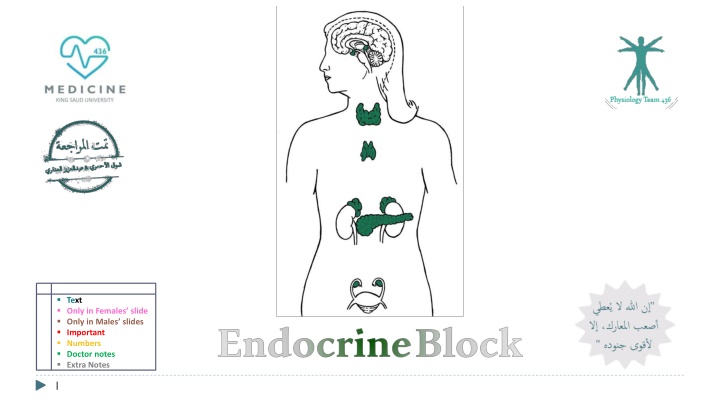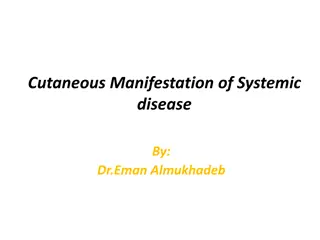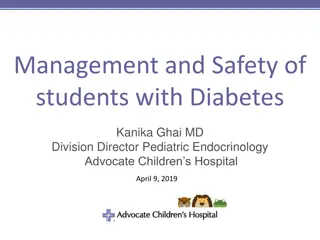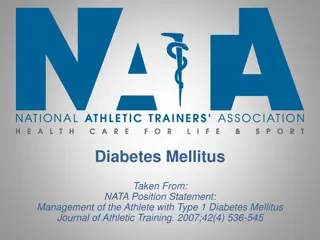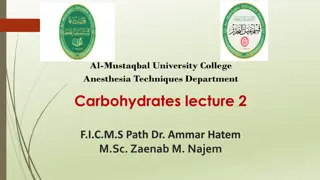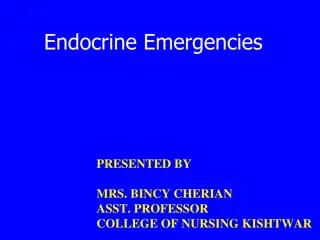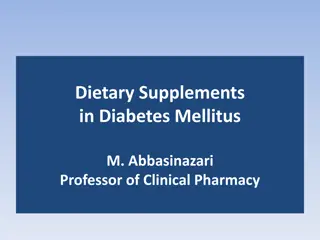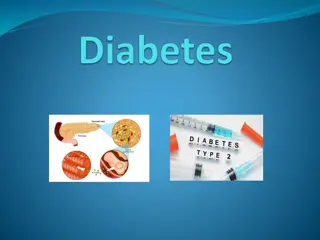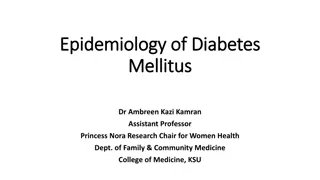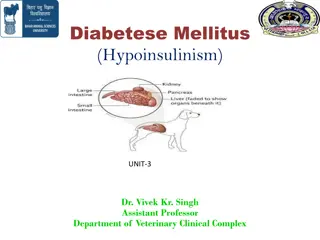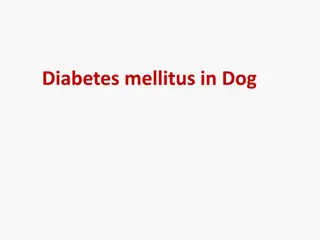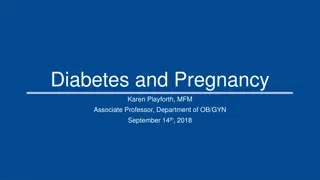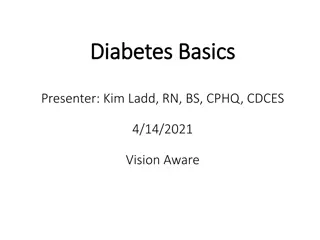Diabetes Mellitus: Consequences and Tests
Diabetes Mellitus is a metabolic disease affecting every cell in the body. It impacts carbohydrate, lipid, and protein metabolism, leading to symptoms like polyuria, polydypsia, and polyphagia. Learn about Type 1, Type 2, and Gestational Diabetes, their implications, and management strategies.
Download Presentation

Please find below an Image/Link to download the presentation.
The content on the website is provided AS IS for your information and personal use only. It may not be sold, licensed, or shared on other websites without obtaining consent from the author.If you encounter any issues during the download, it is possible that the publisher has removed the file from their server.
You are allowed to download the files provided on this website for personal or commercial use, subject to the condition that they are used lawfully. All files are the property of their respective owners.
The content on the website is provided AS IS for your information and personal use only. It may not be sold, licensed, or shared on other websites without obtaining consent from the author.
E N D
Presentation Transcript
Text Only in Females slide Only in Males slides Important Numbers Doctor notes Extra Notes 1
Diabetes Mellitus By the end of this lecture, students should be able to describe: 1. Describe the consequences of insulin deficiency. 2. Outline the Glucose Tolerance Test (GTT). 2
Diabetes Mellitus Diabetes is probably the most important metabolic disease. It affects every cell in the body and affects carbohydrate, lipid, and protein metabolism. Characterized by the polytriad: 1. Polyuria (excessive urination) Guyton:The high blood glucose causes more glucose to filter into the renal tubules than can be reabsorbed. 2. Polydypsia (excessive thirst) Guyton: This occurs partly because glucose doesn't diffuse easily through the pores of the cell membrane, and the increased osmotic pressure in the extracellular fluids causes osmotic transfer of water out of the cells. 3. Polyphagia (excessive hunger). 4
Diabetes Mellitus Types Type 1 Diabetes (autoimmune attack) Type 2 Diabetes Gestational Diabetes Other name Insulin dependent Diabetes Mellitus Insulin independent Diabetes Mellitus Children Adults During Affects More common in some ethnic groups pregnancy Juvenile onset Onset (Specifically designating or pertaining to forms Late onset (about 85%) of diabetes that develop in children or young - adults; especially insulin-dependent diabetes) Inadequate insulin secretion Defect in insulin action (Hyposecretion of insulin) (Insulin resistance keeps blood glucose too high) The inheritance in diabetes is more in type 2 than it is in type 1, it depends on the ethnicity and overall the subject is debatable an not well understood. - Cause Leading to metabolic disturbances (hyperglycemia and glycosuria) - 5
Gestational Diabetes Important Cont. Types Type 1 Diabetes (autoimmune attack) Type 2 Diabetes Immune-mediated selective destruction of cells while cells are preserved. Pathogenesis Therefore no insulin will be secreted high - (during pregnancy) glucagon high production of glucose and ketones by liver. 1. Atherosclerosis. Osmotic diuresis & Diabetic ketoacidosis Complication 2. Renal failure. Coma could be as result of (hyperglycemia,ketoacidosis or dehydration) 3. Blindness Insulin injection Diet or OHA (Oral Hypoglycaemic Agents) Treatment Manage by exercise and diet 6
Symptoms of DM Hyperglycemia. Polyuria (excessive urination) dehydration and soft eyeballs. Polydipsia (excessive thirst) fatigue & weight loss. Polyphagia (excessive hunger). Ketoacidosis (in IDDM) (Acidosis caused by the increased production of ketone bodies, as in diabetic acidosis) Hyperlipidemia. Muscle wasting (There is depletion of muscles). The osmotic diuresis is caused by increased amounts glucose and Electrolyte depletion. ketones. While the diabetic ketoacidosis is caused by an increased amount of keto acids. 7
Long Term Complications of Uncontrolled Diabetes Microvascular disease, Hyperglycemia damages small blood vessels: Diabetic retinopathy vision loss. 1. Diabetic neuropathy damage to nerves most common cause of amputation in western world. 2. Diabetic nephropathy kidney damage chronic renal failure. 3. retinopathy, neuropathy... .1 cardiovascular disease hyperlipidemia microvascular .2 statins + . 8
Important Glucose Tolerance Test (GTT) Both the FPG (Fasting blood glucose) & OGTT (oral glucose tolerance test)tests require that the patient fast for at least 8 hours (ideally 12 hours) prior to the test. The insulin in both situation behaves in a similar manner. The oral glucose tolerance test (OGTT): FPG test. Blood is then taken 2 hours after drinking a special glucose solution. Mechanism of the GTT: Following the oral administration of a standard dose of glucose, the plasma glucose 1. concentration normally rises but returns to the fasting level within 2 hours. If insulin activity is reduced, the plasma glucose concentration takes longer than 2 2. hours to return to normal and often rises above 200 mg/dl. FPG: Fasting blood glucose Measurement of urine glucose allows determination of the renal threshold for 3. PPG: Postprandial Glucose glucose. 9
Important Cont. Result FPG mg/dL 2 hours PPG mg/dL <100 <140 Normal - 140-199 Impaired glucose tolerance 126 200 Diabetes Test ( .) . 8 FPG: Fasting blood glucose PPG: Postprandial Glucose . 10
Important Summary (from slides) Insulin will Increases the Glucose uptake resting muscle. In contradiction of the Exercising muscle it takes up the Glucose even without the action of the Insulin. Best of the luck 11
Summary 12
Thank you for checking our work! . Please check our editing file to know if there are any additions, changes or corrections. : & Examine yourself : 2017-2018 Dr. Manan Al Hakbany s Lecture & Notes. 2017-2018 Dr. Ahmad Alsabeeh s Lecture& Notes. Guyton & Hall of Medical Physiology 13th Edition. Linda S. Costanzo 5th Edition. Helpful physiology bocks. Give us your feedback 13 .
